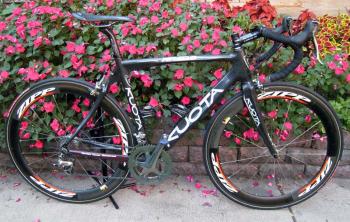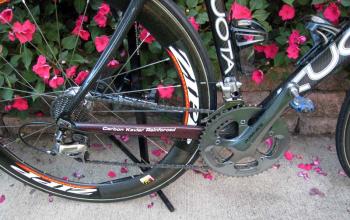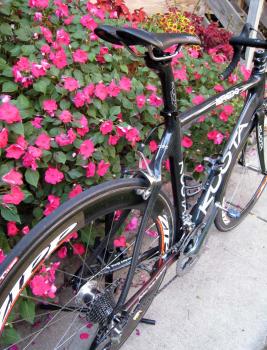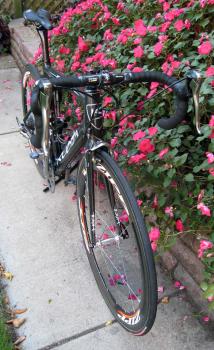Since deciding to start road racing back in January 2005, I’ve had 4 different road bikes. That might seem like a lot, but it’s average for an avid cyclist searching for the perfect ride. Besides, I still have parts from the first ones, so technically each bike hasn’t been a completely new bike! So, what’s my latest ride?
After 3 different Fuji frames, I decided to look for something new. I had nothing against the Fujis. The frames were well made, especially for the price. I’d highly recommend them to someone just starting to race or on a limited budget. I started looking at some of the better US brands…Trek, Cannondale, Giant, Felt, etc. I was looking for a frame that handled well, had stiffness in the right areas, and could help dampen the road vibrations caused by our fine Chicago area pavement. Nothing seemed to really impress me based on my riding style. Ultimately, my experiences with my Kuota Kalibur led me to look at the Kuota Kredo.
The Kuota Kredo design is about 3 years old, but somehow still looks very new and cutting edge. In fact, some its features have been “copied” by other manufacturers (eg, the oversized headtube). Kuota has largely flown under the radar in the road bike market, but has recently become a sensation in triathlete market (the Kalibur was ridden to victory at Kona in 2004 and 2006). They are not cheap bikes, but they’re competitively priced compared to other higher-end, Italian-designed bikes like Pinarello and De Rosa. Once people ride a Kuota, they seemed to get hooked.
Mission Bay Multisport had a Kredo in the size and color I was looking for, so I went to check it out. I was happy they had one in stock because even though the Kuota KOM was the hot new model, the Kredo was hard to come by. I tried a couple of stem lengths for initial fit and went on a few test rides. I really noticed some major differences between the Kredo and my “old” carbon Fuji Team in just a few miles of riding. The Kredo seemed stiffer in the bottom bracket and really jumped when I cranked out of the saddle. Handling felt more sure and it accelerated well out of the corners.
As much as I hated getting rid of my Fuji Team, I was sold on the Kredo. I ended up getting a great end of the season deal on an Ultegra-equipped Kredo. It came stock with Ultegra, but I chose to transfer the Dura Ace group from my Fuji, sell the old frame, and keep the extra parts to build up my Blue CXC cyclocross bike.
After swapping components, one of my first rides was a jaunt up the North Shore to Wilmette. I soon discovered one flaw…my seatpost kept slipping. Thankfully, I had brought along a hex wrench so I could tighten it up on the way. Unfortunately, the potholes of Sheridan road made me stop several times to reset the height. Everything else ran smoothly and the bike felt great (despite all the bumps). And, I don’t mean Charmin-like cushy. The Kredo felt nice and quick, but still had a good dampening effect that was eerily similar to my Kalibur. The bike made me want to take for longer rides and get it racing. That was to come later.
I soon figured out how to solve the seatpost slippage with a little paste from Tacx. I’ve always been scared to over torque carbon, which is why I normally use a torque wrench. Despite torqueing to spec, the seatpost had kept slipping when I hit a bump. Another ride up Sheridan road convinced me that the Tacx paste is the real deal (no slippage occurred after lathering the seatpost). Ironically, I found a crack around the seatpost clamp a few months later. I don’t know if it was related to overtightening the seatpost clamp on my first ride or not. Thankfully, I was able to get a “crash” replacement seatpost through Kuota, and I’ve had not slippage problems since.
Alright, you’re probably bored listening to my seatpost problems, so I’ll get to the rest of the bike. You’ll notice in the photos that the Kredo frame has some nice lines. Some of these are purely cosmetic and others are function oriented. For example, the larger head tube helps absorb shock more and supposedly makes the front more rigid for better acceleration and cornering. The bottom bracket area is oversized to increase stiffness and allow for better power transfer from the cranks. The chainstays have a unique configuration that allows for high power transfer on the right, but improves the ride quality on the left. I’m not an expert on frame mechanics and I got most of my info from the Pezcyclingnews.com review. Overall, I’d say the Kredo has a great looking frame that lives up to the marketing hype when ridden.
For components, I’ve mostly gone with a Shimano drivetrain based on my own preferences. Bikers tend to be Campagnolo people or Shimano people (and now there are SRAM people). Personally, I think all 3 of the companies make good components and you get what you pay for. The best performance is going to come from the more expensive groupsets (eg, Dura Ace, Record, and Red). Since I’ve mostly ridden (and worked on) Shimano, I feel most comfortable with their components. I’ve chosen Dura Ace for its low weight and the way it’s worked for me in the past. OK, so it’s not cheap, but you can now buy a full Dura Ace group for a little over $800 in the EU (the benefits of a global economy). Ultegra is cheaper and works very well, but I’d rather spend a few hundred dollars more to get the top-of-the-line groupset if I’m going to be spending thousands of dollars on a bike.
The rest of my component selection is more of a potpourri. The only part of my drivetrain that is non-Shimano is the Connex Wipperman chain (I love being able to easily remove the chain for cleaning). I also use SRAM Force brakes, because I think they work better than Shimano. I’ve chosen a Ritchey WCS carbon cockpit. I like Ritchey bars and stems because they are very stiff, but not jarring on the road. I’ve got my usual Speedplay pedals and currently prefer the Selle San Marco Aspide Arrowhead saddle. For wheels, I rotate between my homemade training wheels built using the Mavic Open Pro rim and my race wheels which utilize the dimpled Zipp 404 rims. Hubs on either wheelset are Powertap 2.4 SL in the rear and White Industry hubs in the front (just need to get some Salsa skewers). To round out the bling-factor, I’ve got Profile Design Karbon Kage Lites and some Profile Design bar tape. Unfortunately, I use cheap, generic electrical tape. Sorry.
Now for the big question, how has the Kredo ridden over time? As I write this review, I’ve been riding it for just over 4 months. It’s by far my favorite road bike that I’ve owned. I was little hesitant at first about the semi-compact geometry , because I’ve always ridden frames with a more traditional horizontal top tube. No fear. I’ve done a few 4+ hour rides on the Kredo and I’ve felt sore but not overly fatigued. I seem well balanced on the bike. I still need to get an official fit at Mission Bay, but so far things feel OK.
I notice that I’ve been cornering more aggressively and the Kredo feels more stable at high speeds than any bike I’ve ridden before. Acceleration is quick and responsive. I’ve only done one road race with the Kredo and I was very happy with the ride. I used my Zipp 404s in the race, which are more rigid than my Open Pro training wheels. The Kredo was a joy to drive up the hills and fly down. It felt as stiff as the aluminum frames that I’ve ridden, but not as harsh. Even though I got dropped when trapped behind a crash, the rest of the race was a little more enjoyable on my new Kredo. I’d love to race my Kredo more, but my plan is to focus more on TTs. Thankfully, the Kredo is my main training bike.
So, what about flaws? I’ve always had a number of minor complaints about my previous bikes, but trying to find even a few with my Kredo is hard. My biggest complaint, though it’s also a product of getting this level of quality and performance, is the price. The Kredo might be cheap to other bikes of Italian heritage, such as Colnago and Pinarello, but it’s still several thousand dollars worth of bike. I know it sounds weird, the Kredo is expensive but an incredible deal. Go figure.
Well, that’s about it. I think the Kredo is a great value for an Italian-designed, top-of-the-line racing bike. You can find cheaper or pricier bikes, but the Kredo seems to be in the perfect sweet spot if you’re an avid racer and you’ve got the bucks (and want to spend smartly). I know Kuota just made some minor mods to the Kredo for 2008, but it will be hard to improve on this bike as it is. Way to go Kuota!
Frame = Kuota Kredo Carbon – Size M
Fork = Kuota Carbon
Crankset = Shimano Dura Ace 7800 – 170 mm
Cassette = Shimano Dura Ace 7800 – 12-23 10 speed
Shifters = Shimano Dura Ace STI 7800
Chain = Connex Wipperman 10 speed
Front Derailleur = Shimano Dura Ace 7800
Rear Derailleur = Shimano Dura Ace 7800
Brakes = Shimano Dura Ace 7800
Handlebar = Ritchey WCS Carbon 40 cm
Stem = Ritchey WCS Carbon Matrix 120 mm
Seatpost = Kuota Carbon 30.0 mm
Seat = Selle San Marco Aspide
Pedals = Speedplay Zero (stainless steel)
Bottle Cages = Profile Design Elite Karbon Kage
Bar Tape = Deda
Front Wheel (Training) = Mavic Open Pro rim laced to White Industries LTA hub with DT Competition spokes (28, 2X)
Rear Wheel (Training) = Mavic Open Pro rim laced to Powertap 2.4+ hub with DT Competition spokes (32, 2X)
Front Wheel (Racing) = Zipp 404 rim laced to White Industries H1 hub with Sapim CX-Ray spokes (16, radial)
Rear Wheel (Training) = Zipp 404 rim laced to Powertap 2.4+ hub with Sapim CX-Ray spokes (24, 2X)
Bike weight w/training wheels = 16.7 lbs
Bike weight w/racing wheels = 15.6 lbs





Permalink
Hi Peter!
I’m Remi.
I have the same bike, same size and would like to know how tall you are.
I’m 5’11” and tend to think it might be a little small for me.
Thank you!
Permalink
Hi, I no longer have the bike, but I’m 5’8″ with about a 31″ inseam and it fit me perfectly. Thanks!
Permalink
Thank you!!